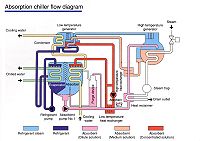Absorption Heaters
Absorption Heaters are also used as Chillers. These heaters are used to absorb particles of gas and liquid in the area that needs heating.
Principle of Operation
1. Chilled water is cooled in evaporator by low temperature refrigerant which has been decompressed and throttled from condenser, and the refrigerant is turned into vapor after absorbing the heat of chilled water, then is absorbed into absorber where the concentrated solution is turned into dilute solution.
2. The dilute solution in the absorber is pumped through low temperature heat exchanger, heat reclaimer, high temperature heat changer where the solution temperature goes up, to the high temperature generator at last, where the dilute solution is heated and condensed into medium solution.
3. The medium solution flows through high temperature heat exchanger, into low temperature generator where the medium solution is heated by the refrigerant vapor which from high temperature generator and turned into final concentrated solution. The concentrated solution flows through low temperature heat exchanger where the temperature goes down, then into the absorber and is sprayed on the cooling water tubes where it absorbs the refrigerant from evaporator and is turned into dilute solution. On the other hand, the vapor in the high temperature generator produced by heating lithium-bromide solution, floats into low temperature generator where it heats the medium solution and itself is coagulated into refrigerant. Then the refrigerant floats into condenser with refrigerant vapor from low temperature generator and is cooled into refrigerant after being decompressed and throttled in the condenser. After that, the refrigerant flows into evaporator where it is sprayed on the condensed coils, cool the chilled water in the evaporator. Above process circles again and again until chilled water is made.
Advantages
- Environment-friendly product
- Low operation noise and vibration
- Conform to national standard of waste emission
- Realize comprehensive energy utilization
- Adopts non-Freon refrigerant
- Adopts non-toxic inhibitor
Video
